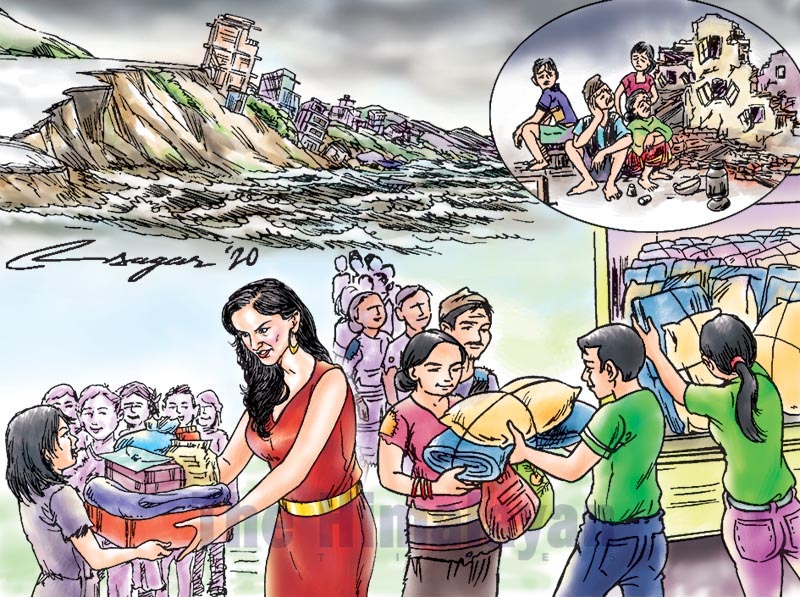Shock responsive social protection: Notable efforts underway in Nepal
Amidst opportunities, challenges also exist to effectively implement SRSP in Nepal. Co-ordination of actors and establishment of an appropriate financing mechanism for the expansion of the system in time of shocks is the key
Social protection is defined as a set of public actions that address the deprivation and vulnerabilities of the poorest, and the need of the currently non-poor for security in the face of shocks and the particular demands of different stages of the life cycle. It could be labelled as ‘social assistance’, ‘social care’, ‘social insurance’, and ‘labour market policies’. Social protection is thus an investment in people and the country as it eases the budget constraint of households allowing them to invest.
Social protection programmes implemented in Nepal include child grants; cash transfers for senior citizens, people with disabilities, endangered ethnic communities and single women; support to the Karnali Employment Programme; and other poverty reduction, micro-insurance initiatives.
All social protections deal with shocks in some way. The social protection sector can contribute by building households’ resilience to shocks, preparing systems and programmes, recognising that shocks may happen and supporting people after the shock. In the current context of shocks, such as natural disasters, pandemics, conflict and violence, there is a need to think about how social protection models can be made shock responsive, scalable or adaptive.
Global literature suggests five key options for shock-responsive adaptation - design tweaks (making small adjustments to the design of the core programme); piggybacking (borrowing elements of an existing programme or system while delivering a separate emergency response); vertical expansion (topping up support to beneficiaries); horizontal expansion (temporarily extending support to new households); and alignment of humanitarian interventions with one another.
Shock responsive social protection (SRSP) seeks to improve the preparedness of the social protection system to respond to shocks. It targets mostly the marginalised people, especially children, lactating women, elderly, Dalits and persons with disabilities. Integration of Gender Equality and Social Inclusion (GESI) into the development planning at the Palika and provincial level has been initiated to benefit those who are most vulnerable.
There have also been some notable efforts in the country on SRSP in terms of evidence generation and pilot interventions. Following the devastating earthquake in Nepal in 2015, UNICEF, through government support, carried out a $24 million Emergency Cash Transfer Programme (ECTP) in two phases. Phase 1 covered 19 districts with 434,000 beneficiaries whereas Phase II covered 11 districts with 317,000 beneficiaries. Similarly, a collaborative project of the government, DFID and UNICEF is implementing a pilot project on shock responsive preparedness in eight most disaster-prone Palikas. Likewise, evidence generation is ongoing to assess the effectiveness of the existing social protection system to respond to floods.
The World Bank also conducted a three-year Panel Survey between 2016 and 2018, covering 18,000 households in 50 districts. For natural disasters, assets fell by 7-12% in the year of the shock. Households were 3.5-6.5% more likely to be moderately or severely food insecure that year. The survey findings show that most households rely on savings and borrowing to cope with shocks. However, they borrow at higher interest rates, especially the poor and in more remote areas. A large minority have to resort to reducing food and other expenditures.
Amidst opportunities, challenges also exist to effectively implement SRSP in Nepal. Co-ordination of actors and establishment of an appropriate financing mechanism for the expansion of the system in time of shocks is the key. Registration of new beneficiaries along with effective communication is also necessary to explain why certain people are suddenly being covered by the programme and then dropped.
Manual and decentralised record keeping of the beneficiary’s information is a major hurdle for addressing issues of duplication, under-coverage and weak oversight facing the administration of the social assistance programmes. So, there are concerns of data quality and validity.
As the social protection system must also respond to shocks, it involves a trade-off with some of the key criteria underpinning humanitarian response, such as timeliness, coverage of the affected population and adequacy of the support provided. Mitigating the extent to which this is the case requires a legislative framework and institutional architecture that is built for the purpose. Funding mechanism is another key aspect. SRSP requires a funding mechanism to which multiple donors can contribute.
As SRSP implementation requires multi-sectoral engagement, coordination of all stakeholders is pivotal. Coordination should also be linked to national early warning monitoring systems so as to prepare in advance for an approaching emergency.
Thus, there is a need to integrate social protection expansion as a response mechanism into the national disaster management framework; improve local capacity through both regular systems strengthening and contingency planning; develop complementary standard operating procedures for emergency contexts; and identify ways that humanitarian actors can support or complement disaster response through existing government systems.






